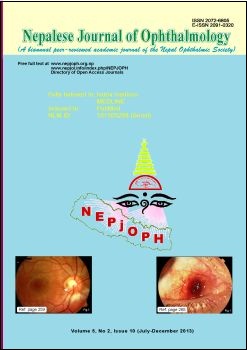Outcome of the patients with post-operative cluster endophthalmitis referred to a tertiary level eye care center in Nepal
DOI:
https://doi.org/10.3126/nepjoph.v5i2.8735Keywords:
cataract surgery, endophthalmitis, postoperativeAbstract
Introduction: The causative organism and treatment outcomes of post operative endophthalmitis may vary depending on several factors.
Objective: To find out the causative organisms and visual outcome after an outbreak of post-operative endophthalmitis.
Materials and methods: An interventional prospective series of cases of clinically suspected endophthalmitis was studied. Eleven patients who presented within 48 hours after manual cataract surgery on the same day, by a one surgeon in a single center were enrolled in the study. They underwent both anterior chamber and vitreous aspiration and all of them received intravitreal Vancomycin, Amikacin and Dexamethasone. Samples were subjected to microbiological evaluation. All patients were followed up till 8 weeks for clinical and visual outcome.
Results: Of the 11 eyes of suspected endopthalmitis, only one vitreous aspiration showed Gram negative bacilli on Gram stain and 3 vitreous aspirates showed Gram positive cocci. Of the 11 eyes, 3(42.85%) had culture positive on vitreous aspirate. In 2 cases E Coli was isolated and in 1 Staphylococcus aureus was isolated. After 48 hours of intravitreal injection, 10 out of 11 eyes improved and in one, intravitreal injection of vancomycin, amikacin and dexamethasone was repeated. The best corrected visual acuity of 6/9 was achieved in 2 patients, 5 had 6/18, 2 had 6/60 and 2 had 5/60 at the end of eight weeks.
Conclusion: Staphylococcus aureus and E coli can cause endophthalmitis immediately on the first day post-operatively. Clinically suspected endophthalmitis treated with antibiotics and steroid intravitreal injection can result in better visual outcome.
Nepal J Ophthalmol 2013; 5(10): 235-241
Downloads
Downloads
Published
How to Cite
Issue
Section
License
This license enables reusers to copy and distribute the material in any medium or format in unadapted form only, for noncommercial purposes only, and only so long as attribution is given to the creator.




